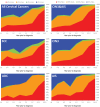Relative Performance of HPV and Cytology Components of Cotesting in Cervical Screening
- PMID: 29145648
- PMCID: PMC6279277
- DOI: 10.1093/jnci/djx225
Relative Performance of HPV and Cytology Components of Cotesting in Cervical Screening
Abstract
Background: The main goal of cervical screening programs is to detect and treat precancer before cancer develops. Human papillomavirus (HPV) testing is more sensitive than cytology for detecting precancer. However, reports of rare HPV-negative, cytology-positive cancers are motivating continued use of both tests (cotesting) despite increased testing costs.
Methods: We quantified the detection of cervical precancer and cancer by cotesting compared with HPV testing alone at Kaiser Permanente Northern California (KPNC), where 1 208 710 women age 30 years and older have undergone triennial cervical cotesting since 2003. Screening histories preceding cervical cancers (n = 623) and precancers (n = 5369) were examined to assess the relative contribution of the cytology and HPV test components in identifying cases. The performances of HPV testing and cytology were compared using contingency table methods, general estimating equation models, and nonparametric statistics; all statistical tests were two-sided.
Results: HPV testing identified more women subsequently diagnosed with cancer (P < .001) and precancer (P < .001) than cytology. HPV testing was statistically significantly more likely to be positive for cancer at any time point (P < .001), except within 12 months (P = .10). HPV-negative/cytology-positive results preceded only small fractions of cases of precancer (3.5%) and cancer (5.9%); these cancers were more likely to be regional or distant stage with squamous histopathology than other cases. Given the rarity of cancers among screened women, the contribution of cytology to screening translated to earlier detection of at most five cases per million women per year. Two-thirds (67.9%) of women found to have cancer during 10 years of follow-up at KPNC were detected by the first cotest performed.
Conclusions: The added sensitivity of cotesting vs HPV alone for detection of treatable cancer affected extremely few women.
Figures

Similar articles
-
Why does cervical cancer occur in a state-of-the-art screening program?Gynecol Oncol. 2017 Sep;146(3):546-553. doi: 10.1016/j.ygyno.2017.06.003. Epub 2017 Jun 10. Gynecol Oncol. 2017. PMID: 28606721 Free PMC article.
-
p16/Ki-67 Dual Stain Cytology for Detection of Cervical Precancer in HPV-Positive Women.J Natl Cancer Inst. 2015 Sep 15;107(12):djv257. doi: 10.1093/jnci/djv257. Print 2015 Dec. J Natl Cancer Inst. 2015. PMID: 26376685 Free PMC article.
-
Risk of precancer and follow-up management strategies for women with human papillomavirus-negative atypical squamous cells of undetermined significance.Obstet Gynecol. 2007 Jun;109(6):1325-31. doi: 10.1097/01.AOG.0000263461.71732.40. Obstet Gynecol. 2007. PMID: 17540804 Clinical Trial.
-
Overview of human papillomavirus-based and other novel options for cervical cancer screening in developed and developing countries.Vaccine. 2008 Aug 19;26 Suppl 10:K29-41. doi: 10.1016/j.vaccine.2008.06.019. Vaccine. 2008. PMID: 18847555 Review.
-
Cytology at the Time of HPV: Some Things to Think about when Discussing HPV.Acta Cytol. 2016;60(6):527-533. doi: 10.1159/000450821. Epub 2016 Nov 5. Acta Cytol. 2016. PMID: 27816982 Review.
Cited by
-
Cervical screening and risk of adenosquamous and rare histological types of invasive cervical carcinoma: population based nested case-control study.BMJ. 2019 Apr 3;365:l1207. doi: 10.1136/bmj.l1207. BMJ. 2019. PMID: 30944091 Free PMC article.
-
The Next Generation of Cervical Cancer Screening: Should Guidelines Focus on Best Practices for the Future or Current Screening Capacity?J Low Genit Tract Dis. 2018 Apr;22(2):91-96. doi: 10.1097/LGT.0000000000000378. J Low Genit Tract Dis. 2018. PMID: 29570563 Free PMC article. No abstract available.
-
Cotesting in Cervical Cancer Screening.Am J Clin Pathol. 2021 Jan 4;155(1):150-154. doi: 10.1093/ajcp/aqaa169. Am J Clin Pathol. 2021. PMID: 33270087 Free PMC article. No abstract available.
-
Evidence of Decreased Long-term Risk of Cervical Precancer after Negative Primary HPV Screens Compared with Negative Cytology Screens in a Longitudinal Cohort Study.Cancer Epidemiol Biomarkers Prev. 2024 Jul 1;33(7):904-911. doi: 10.1158/1055-9965.EPI-23-1587. Cancer Epidemiol Biomarkers Prev. 2024. PMID: 38773687 Free PMC article.
-
Contributions of Liquid-Based (Papanicolaou) Cytology and Human Papillomavirus Testing in Cotesting for Detection of Cervical Cancer and Precancer in the United States.Am J Clin Pathol. 2020 Sep 8;154(4):510-516. doi: 10.1093/ajcp/aqaa074. Am J Clin Pathol. 2020. PMID: 32637991 Free PMC article.
References
-
- Schiffman M, Castle PE, Jeronimo J, Rodriguez AC, Wacholder S.. Human papillomavirus and cervical cancer. Lancet. 2007;370(9590):890–907. - PubMed
-
- Cuzick J, Clavel C, Petry KU et al. , Overview of the European and North American studies on HPV testing in primary cervical cancer screening. Int J Cancer. 2006;119(5):1095–1101. - PubMed
-
- Mayrand MH, Duarte-Franco E, Rodrigues I et al. , Human papillomavirus DNA versus Papanicolaou screening tests for cervical cancer. N Engl J Med. 2007;357(16):1579–1588. - PubMed
-
- Naucler P, Ryd W, Tornberg S et al. , Human papillomavirus and Papanicolaou tests to screen for cervical cancer. N Engl J Med. 2007;357(16):1589–1597. - PubMed
-
- Rijkaart DC, Berkhof J, Rozendaal L et al. , Human papillomavirus testing for the detection of high-grade cervical intraepithelial neoplasia and cancer: Final results of the POBASCAM randomised controlled trial. Lancet Oncol. 2012;13(1):78–88. - PubMed

